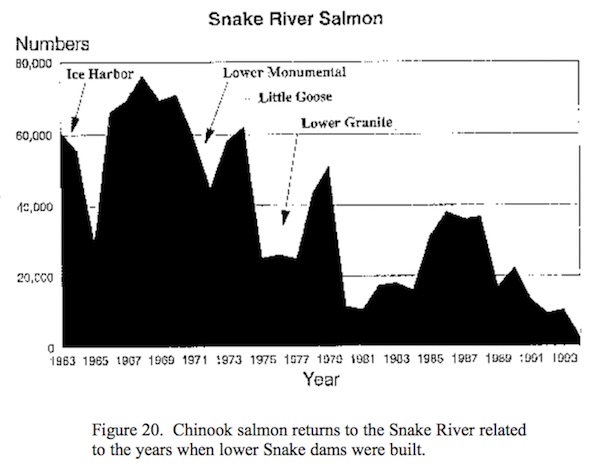forum
library
tutorial
contact

Removal of Unproductive Dams
Best for Salmon
by Kurt Miller
The Observer, January 5, 2021
|
the film forum library tutorial contact |

|
Removal of Unproductive Dams
by Kurt Miller
|
 I'm incredibly honored to work as a hydropower advocate. My organization champions clean energy, works to fight climate change and campaigns for fair and equitable electricity access for communities across the Pacific Northwest. It's a mission we proudly embrace.
I'm incredibly honored to work as a hydropower advocate. My organization champions clean energy, works to fight climate change and campaigns for fair and equitable electricity access for communities across the Pacific Northwest. It's a mission we proudly embrace.
That said, I've learned some issues are incredibly complex. Perhaps the most frequent question I hear regards the effect of dams on salmon and the implications of struggling salmon populations for Indigenous peoples.
I've had many conversations with Native American tribal members, and I'm deeply moved by the central role salmon play in their respective religions, economies, cultures and matters of food security. My organization embraces the critical goal of restoring healthy salmon populations, and we continue to partner on efforts to achieve that goal.
As a result, when we advocate for hydropower, we encourage people to try to think differently if they equate being a hydropower advocate with being a salmon adversary.
A multitude of studies released this year prove that you don't have to "pick a side" when it comes to hydropower and salmon. This research demonstrates that climate change -- especially the effect of warming, acidifying oceans -- is the greatest threat to salmon survival up and down the Pacific Coast of North America.
Scientists have found that pristine rivers without dams have seen very similar declines in survival compared to rivers with dams over the past 50 years. This finding points to the salmon's shared environment -- the ocean -- as the main culprit. NOAA Fisheries even came to the shocking conclusion that chinook salmon may only have 20 to 30 years left if ocean temperatures continue to warm at the current rate.
If these studies are correct, then hydropower is a critical salmon recovery tool. Hydropower represents 90% of our region's renewable energy, which makes it our strongest climate change-fighting resource.
Also, as recently acknowledged by the Union of Concerned Scientists, hydropower is especially valuable in its ability to help us add intermittent renewable energy to the grid. Hydroelectric dams act like giant, clean energy batteries that can store water and then release it past turbines to produce electricity when needed.
That said, not all dams are created equal, which is why my organization only advocates for hydropower dams that provide meaningful societal and environmental benefits. A good example is the lower Snake River dams, which produce enough carbon-free electricity to power a city the size of Seattle.
These Eastern Washington dams have some of the most advanced fish passage systems in the world.
Based upon this organizational philosophy, we applaud the decisions that led to the removal of the Elwha River dams, Condit Dam, and the recent agreement to remove the Klamath River dams.
None of the aforementioned dams produced large amounts of electricity, and they were constructed without fish passage capabilities.
As our name indicates, Northwest RiverPartners stands ready to partner with organizations on solutions that help remove unproductive dams from service, especially if those removals can benefit salmon. Our members believe that our organization can be a model for how to face these challenges with an honest and nuanced approach.
It is an approach that recognizes the value of productive hydroelectric resources to communities, to the environment, to salmon, and to the people who depend on them.
learn more on topics covered in the film
see the video
read the script
learn the songs
discussion forum
